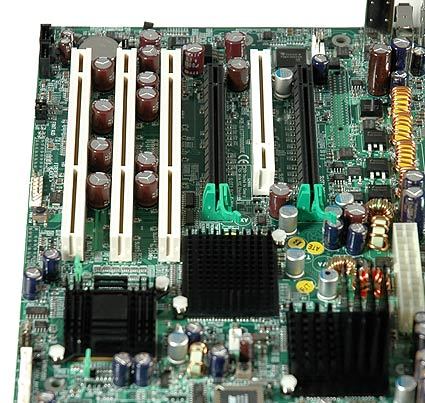PCI Express Battles PCI-X
PCI-X Explained
PCI-X is a highly upgraded version of the parallel Peripheral Components Interconnect (PCI) bus. It is a classic bus topology, and requires a large number of pins for connections. As mentioned before, the available bandwidth is shared between all attached devices.
Unlike the conventional PCI in your computer system, which is 32 bits wide, PCI-X is 64 bits wide. As a result, the bandwidth is automatically twice as high as what 32-bit PCI can deliver, and the slot connector obviously is much larger as well. Yet everything else, including the transfer protocols, signals and basic connector types, are compatible. This allows 3.3 V 32 Bit PCI cards to run in PCI-X slot. It is also possible to run many 64 Bit PCI-X cards in 32 Bit PCI slots, but at dramatically reduced bandwidth.
The bus width upgrade would still not be good enough to provide enough bandwidth for expansion devices such as professional storage controllers for SCSI, iSCSI, Fibre Channel, 10 Gbit Ethernet, InfiniBand and others. Therefore, the PCI-SIG (Special Interest Group) introduced several speed grades, ranging from PCI-X 66 (Rev. 1.0b) all the way up to PCI-X 533 (Rev. 2.0). The following table shows the technical details:
| Header Cell - Column 0 | Bus Width | Clock Speed | Features | Bandwidth |
|---|---|---|---|---|
| PCI-X 66 | 64 Bits | 66 MHz | Hot Plugging, 3.3 V | 533 MB/s |
| PCI-X 133 | 64 Bits | 133 MHz | Hot Plugging, 3.3 V | 1.06 GB/s |
| PCI-X 266 | 64 Bits, optional 16 Bits only | 133 MHz Double Data Rate | Hot Plugging, 3.3 & 1.5 V, ECC supported | 2.13 GB/s |
| PCI-X 533 | 64 Bits, optional 16 Bits only | 133 MHz Quad Data Rate | Hot Plugging, 3.3 & 1.5 V, ECC supported | 4.26 GB/s |
As you can see, the clock speed was not further increased when hitting 133 MHz with PCI-X 133. In order to achieve even more bandwidth, two techniques were used that most of you already know from their use in main memory technologies and front side buses. PCI-X 266 makes use of Double Data Rate technology, transferring data both on the rising and the falling edges of a clock cycle. PCI-X 533 goes one step further and implements four data transfers per clock cycles (Quad Data Rate). Intel has been using this technique for the front side bus of all Pentium 4 and Xeon processors since their introduction.
The white slots to the left are 64 Bit PCI-X.
Get Tom's Hardware's best news and in-depth reviews, straight to your inbox.
Current page: PCI-X Explained
Prev Page Is PCI Express Really Any Better Than PCI-X? Next Page PCI-X Modes Compared
Patrick Schmid was the editor-in-chief for Tom's Hardware from 2005 to 2006. He wrote numerous articles on a wide range of hardware topics, including storage, CPUs, and system builds.
-
herb2021 Buyers need to be very aware of limited compatiblility with many of today's MB. Will not work in many machines. Highpoint Tech support is one of the worst I have worked with. No indication of any technical ability in those I have worked with.Reply

